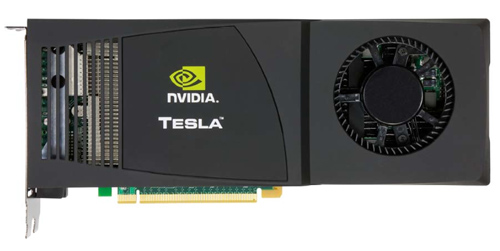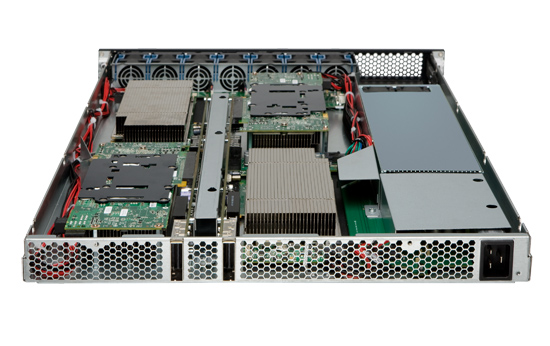NVIDIA's Fermi: Architected for Tesla, 3 Billion Transistors in 2010
by Anand Lal Shimpi on September 30, 2009 12:00 AM EST- Posted in
- GPUs
A Different Sort of Launch
Fermi will support DirectX 11 and NVIDIA believes it'll be faster than the Radeon HD 5870 in 3D games. With 3 billion transistors, it had better be. But that's the extent of what NVIDIA is willing to talk about with regards to Fermi as a gaming GPU. Sorry folks, today's launch is targeted entirely at Tesla.

A GeForce GTX 280 with 4GB of memory is the foundation for the Tesla C1060 cards
Tesla is NVIDIA's High Performance Computing (HPC) business. NVIDIA takes its consumer GPUs, equips them with a ton of memory, and sells them in personal or datacenter supercomputers called Tesla supercomputers or computing clusters. If you have an application that can run well on a GPU, the upside is tremendous.

Four of those C1060 cards in a 1U chassis make the Tesla S1070. PCIe connects the S1070 to the host server.
NVIDIA loves to cite examples of where algorithms ported to GPUs work so much better than CPUs. One such example is a seismic processing application that HESS found ran very well on NVIDIA GPUs. It migrated a cluster of 2000 servers to 32 Tesla S1070s, bringing total costs down from $8M to $400K, and total power from 1200kW down to 45kW.
| HESS Seismic Processing Example | Tesla | CPU |
| Performance | 1 | 1 |
| # of Machines | 32 Tesla S1070s | 2000 x86 servers |
| Total Cost | ~$400K | ~$8M |
| Total Power | 45kW | 1200kW |
Obviously this doesn't include the servers needed to drive the Teslas, but presumably that's not a significant cost. Either way the potential is there, it's just a matter of how many similar applications exist in the world.
According to NVIDIA, there are many more cases like this in the market. The table below shows what NVIDIA believes is the total available market in the next 18 months for these various HPC segments:
| Processor | Seismic | Supercomputing | Universities | Defence | Finance |
| GPU TAM | $300M | $200M | $150M | $250M | $230M |
These figures were calculated by looking at the algorithms used in each segment, the number of Hess-like Tesla installations that can be done, and the current budget for non-GPU based computing in those markets. If NVIDIA met its goals here, the Tesla business could be bigger than the GeForce one. There's just one problem:
As you'll soon see, many of the architectural features of Fermi are targeted specifically for Tesla markets. The same could be said about GT200, albeit to a lesser degree. Yet Tesla accounted for less than 1.3% of NVIDIA's total revenue last quarter.
Given these numbers it looks like NVIDIA is building GPUs for a world that doesn't exist. NVIDIA doesn't agree.
The Evolution of GPU Computing
When matched with the right algorithms and programming efforts, GPU computing can provide some real speedups. Much of Fermi's architecture is designed to improve performance in these HPC and other GPU compute applications.
Ever since G80, NVIDIA has been on this path to bring GPU computing to reality. I rarely get the opportunity to get a non-marketing answer out of NVIDIA, but in talking to Jonah Alben (VP of GPU Engineering) I had an unusually frank discussion.
From the outside, G80 looks to be a GPU architected for compute. Internally, NVIDIA viewed it as an opportunistic way to enable more general purpose computing on its GPUs. The transition to a unified shader architecture gave NVIDIA the chance to, relatively easily, turn G80 into more than just a GPU. NVIDIA viewed GPU computing as a future strength for the company, so G80 led a dual life. Awesome graphics chip by day, the foundation for CUDA by night.
Remember that G80 was hashed out back in 2002 - 2003. NVIDIA had some ideas of where it wanted to take GPU computing, but it wasn't until G80 hit that customers started providing feedback that ultimately shaped the way GT200 and Fermi turned out.
One key example was support for double precision floating point. The feature wasn't added until GT200 and even then, it was only added based on computing customer feedback from G80. Fermi kicks double precision performance up another notch as it now executes FP64 ops at half of its FP32 rate (more on this later).
While G80 and GT200 were still primarily graphics chips, NVIDIA views Fermi as a processor that makes compute just as serious as graphics. NVIDIA believes it's on a different course, at least for the short term, than AMD. And you'll see this in many of the architectural features of Fermi.










415 Comments
View All Comments
shotage - Thursday, October 1, 2009 - link
lol*shakes head*
palladium - Thursday, October 1, 2009 - link
Ahh, he said a 9800 GTX + GDDR5 = 4870 !blindbox - Thursday, October 1, 2009 - link
Ooops, I think I need to speak something on topic at least. Anyone could tell me if OpenCL SDK is out yet? Or DirectCompute too? It has been over a year since GPU computing was announced and nothing useful for the consumers (I don't call folding for consumers).habibo - Thursday, October 1, 2009 - link
Yes, both OpenCL and DirectCompute are available for development. It will take time for developers to release applications that use these APIs.There are already consumer applications that use CUDA, although these are mostly video encoding, Folding@Home/SETI@home, and PhysX-based games. Possibly not too exciting to you, but hopefully more will be coming as GPU computing gains traction.
PorscheRacer - Thursday, October 1, 2009 - link
Does anyone know if the 5000 series support hardware virtualisation? I think this will be the killer feature once AMD's 800 series chipsets debut here shortly. Being able to virtualise the GPU and other hardware with your virtual machines is the last stop to pure bliss.dgz - Thursday, October 1, 2009 - link
I am also curious. Right now only nVidia's Quadro cards support this.The thing is, though, that your CPU and chipset also have to support what Intel calls VT-d.
Being able to play 3D games in virtual OS with little to no performance would be great and useful.
Not going to happen soon, though. It's also funny that virtually no one Lynnfield mentioned the lack of VT-d in 750 in his "deep" review. Huge disappointment.
wifiwolf - Thursday, October 1, 2009 - link
If there's any technology that seams to scratch that virtualization, i think this new gt300 is the one. When reading about nvidia making the card compute oriented it just drove my mind to that thought. Hope i'm right. To be fair with amd, i think their doubled stream processors could be a step forward in that direction too, coupled with dx11 direct compute. Virtual machines just need to acknowledge the cards and capabilities.dgz - Friday, October 2, 2009 - link
They already do. vmware and vbox have such capabilities. Not everything is possible atm, though.dgz - Thursday, October 1, 2009 - link
oops, I meant "little to no performance penalty" :)sigmatau - Thursday, October 1, 2009 - link
According to the super troll who keeps screeching about bandwidth, then the GT300 must be a lesser card since it doesn't have 512 bit connection like the GT200.LOL @ Trolls.